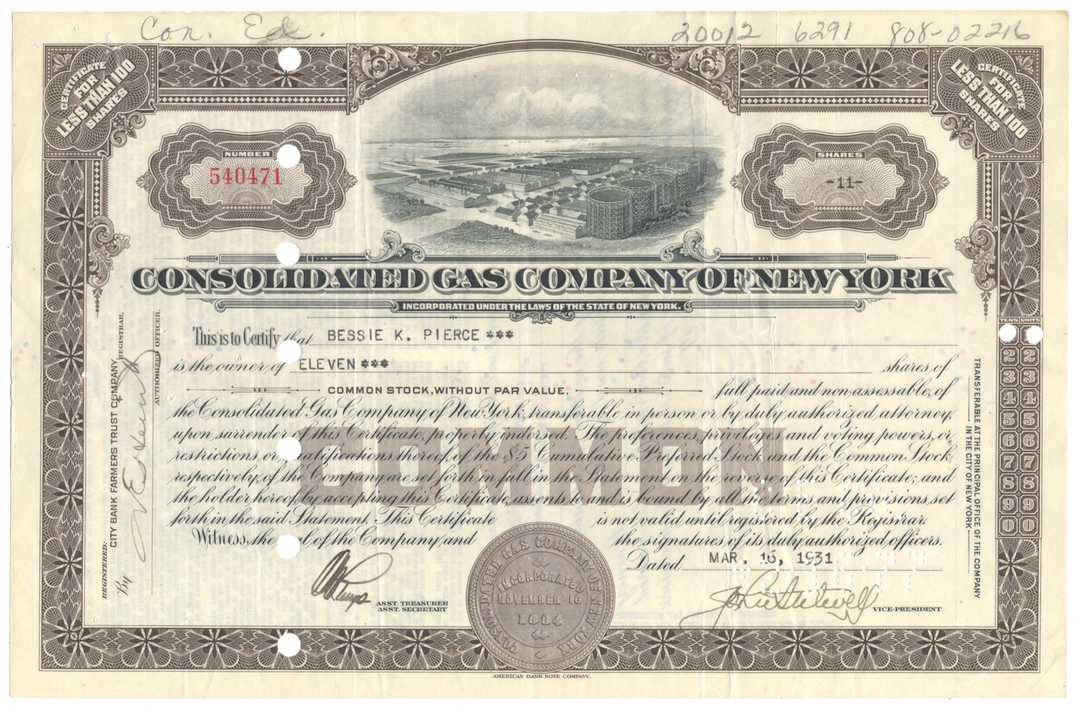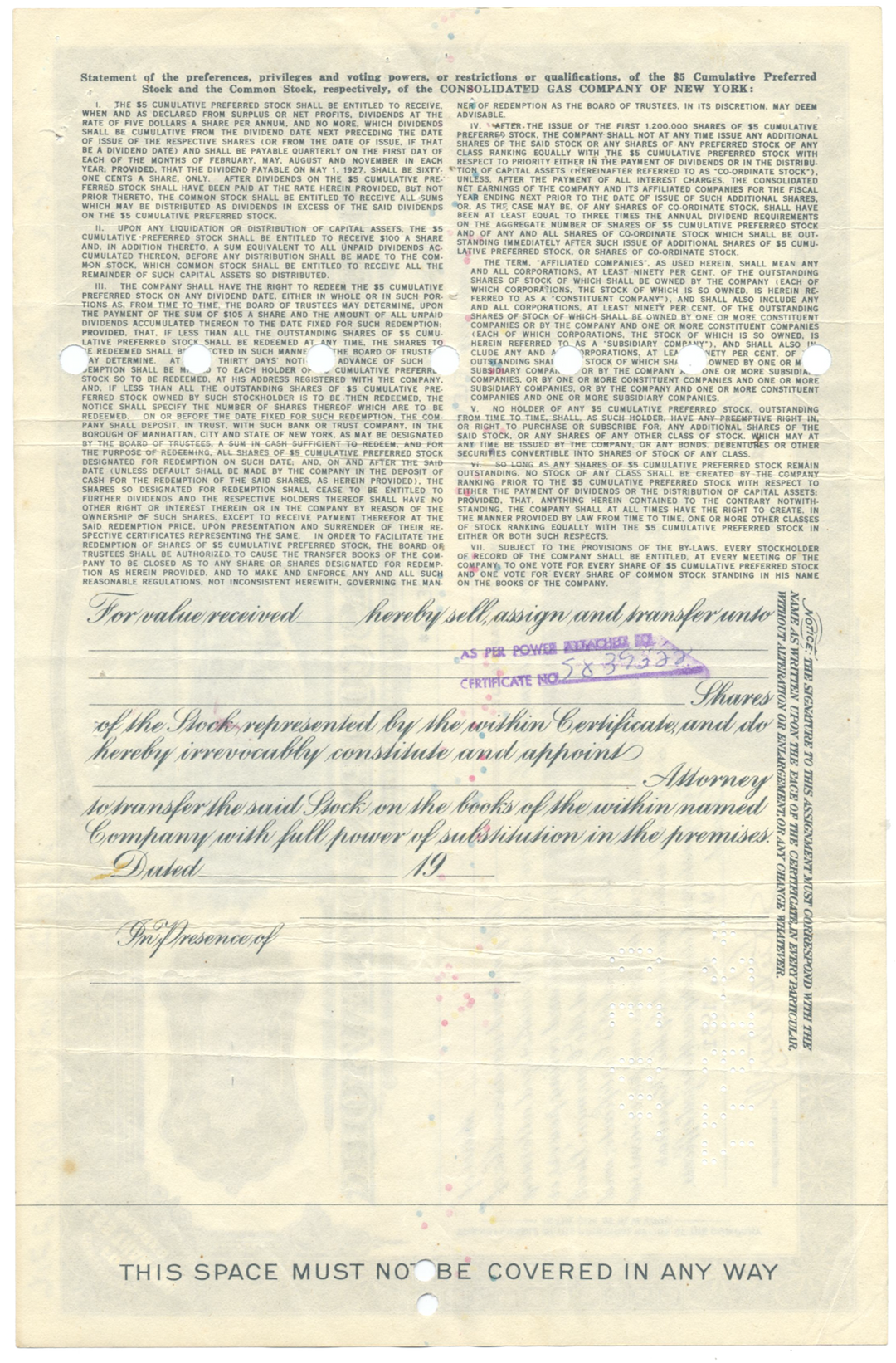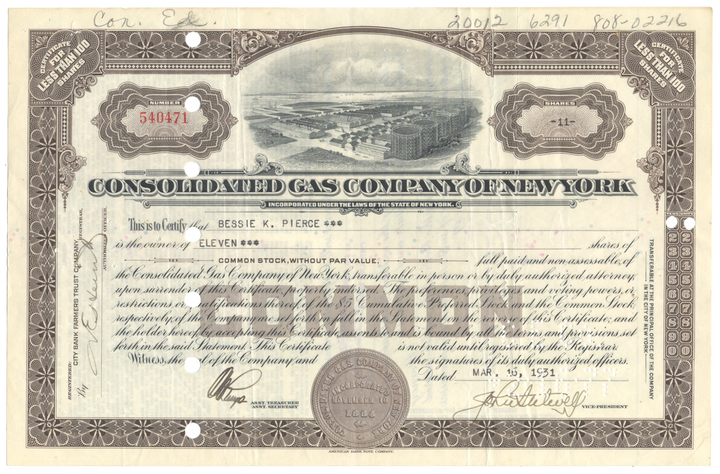Consolidated Gas Company of New York
- Guaranteed authentic document
- Orders over $75 ship FREE to U. S. addresses
You will receive the exact certificate pictured
Over 75 years old
Common stock
March 16, 1931
Issued, canceled
American Bank Note Company
Hand signed
11" (w) by 7" (h)
NA
Historical Context
In 1884 the New York City's six largest gas concerns joined forces as a new utility giant called Consolidated Gas Company of New York. This merger initiated a long process whereby the scores of small electricity, gas, and steam companies operating in the greater New York area would be melded into the single and far more efficient entity known since 1936 as Consolidated Edison Company of New York. At first, the electric and gas concerns faced each other as rivals, each side augmenting its forces by annexation or combination with neighboring firms.
The gas companies, including New York Gas Light Company, were united in Consolidated Gas, while the bulk of Manhattan's electricity supply was collected in 1898 under the umbrella of The New York Gas & Electric Light, Heat & Power Company (NYG&ELH&P). NYG&ELH&P also gained a controlling share of Edison Electric Illuminating. Consolidated Gas bought NYG&ELH&P in 1899, when Consolidated Gas decided to use its superior financial might to overcome a growing technological gap by buying up as many electricity companies as it could. In 1901 Consolidated Gas merged the electric companies it controlled, including Edison Electric Illuminating, NYG&ELH&P, and others into a single subsidiary known as The New York Edison Company. Thus the gas companies themselves became providers of electricity, and by 1910 controlled, under the name of New York Edison, most of the electricity generated in Manhattan and the western portion of the Bronx.
By that time, of course, electricity had become the standard source of power not only for illumination but for a widening variety of household gadgets and industrial tools. Alternating current had won the day, allowing the construction of very large central generators capable of serving vast numbers of customers at long distances. New York Edison gradually replaced its last few small DC-generating stations, and the city's power network began to assume its modern structure. In particular, as it became apparent that large-scale power distribution was by nature a type of monopoly, utility companies came under the regulatory control of the state legislature in Albany, New York. The power of the legislature to fix rates of return for utilities was tested in a landmark court case arising out of its 1906 attempt to limit Consolidated Gas's price for its gas to 80 cents per 1,000 cubic feet. The United States Supreme Court eventually ruled that while governmental bodies had a clear right to oversee the operation of utilities, they could not set rates so low as to prevent the utilities from earning a reasonable rate of return on investment; in the case of Consolidated Gas, however, the rate of 80 cents was not found to be excessively low. In the course of its analysis, the Court estimated Consolidated Gas's asset value at $56 million.
For many years Consolidated Gas and its subsidiary New York Edison grew quietly. The long process of unifying New York's various power companies continued, and by 1932 Consolidated Gas was the largest company in the world providing electrical service. The final step occurred in 1936 when Consolidated Gas became Consolidated Edison Company of New York.
Related Collections
Additional Information
Certificates carry no value on any of today's financial indexes and no transfer of ownership is implied. All items offered are collectible in nature only. So, you can frame them, but you can't cash them in!
All of our pieces are original - we do not sell reproductions. If you ever find out that one of our pieces is not authentic, you may return it for a full refund of the purchase price and any associated shipping charges.









